Evaluating Life Cycle Costing for Circular Economy SME Business Models
VerifiedAdded on 2023/06/14
|6
|1197
|316
Report
AI Summary
This report investigates the feasibility of life cycle costing (LCC) for circular economy business models, focusing on Small and Medium Enterprises (SMEs) in Bangladesh, particularly within the water sector, with potential applications in agriculture and food. It aims to identify options for applying LCC to benefit SMEs in Bangladesh's circular economy by analyzing factors in water resource management, assessing the impact of SMEs on circular economy business models, and determining the scope for water management to improve the food and agriculture sector. The research employs a SWOT analysis to evaluate the strengths, weaknesses, opportunities, and threats related to water governance institutions in Bangladesh, highlighting the mismanagement of water resources despite their abundance. The study concludes that while there is significant potential for LCC implementation in the water sector, the lack of coordination among institutions hinders the successful implementation of international water resource management systems. Desklib offers solved assignments and resources for students.
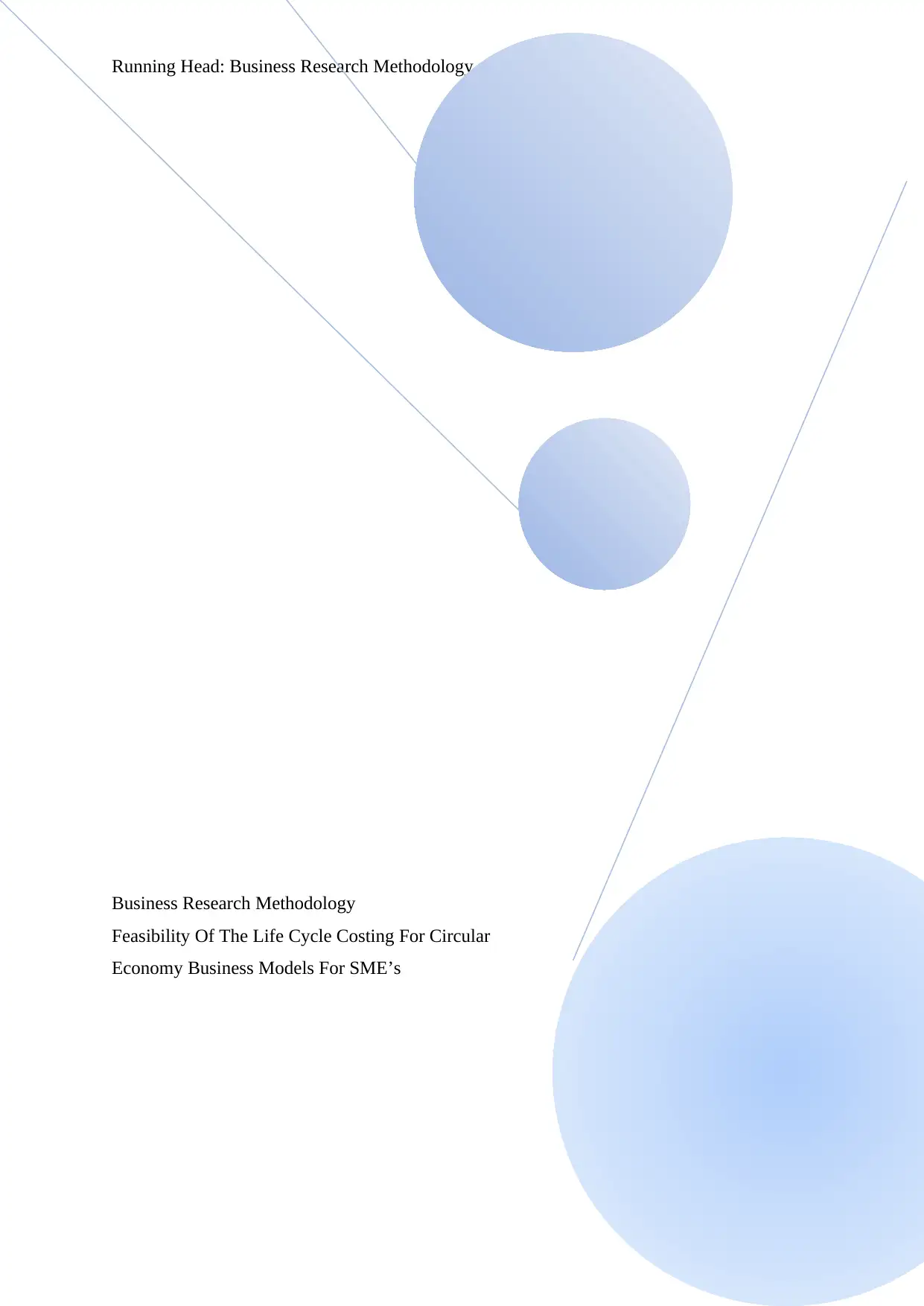
Running Head: Business Research Methodology
Business Research Methodology
Feasibility Of The Life Cycle Costing For Circular
Economy Business Models For SME’s
Business Research Methodology
Feasibility Of The Life Cycle Costing For Circular
Economy Business Models For SME’s
Paraphrase This Document
Need a fresh take? Get an instant paraphrase of this document with our AI Paraphraser
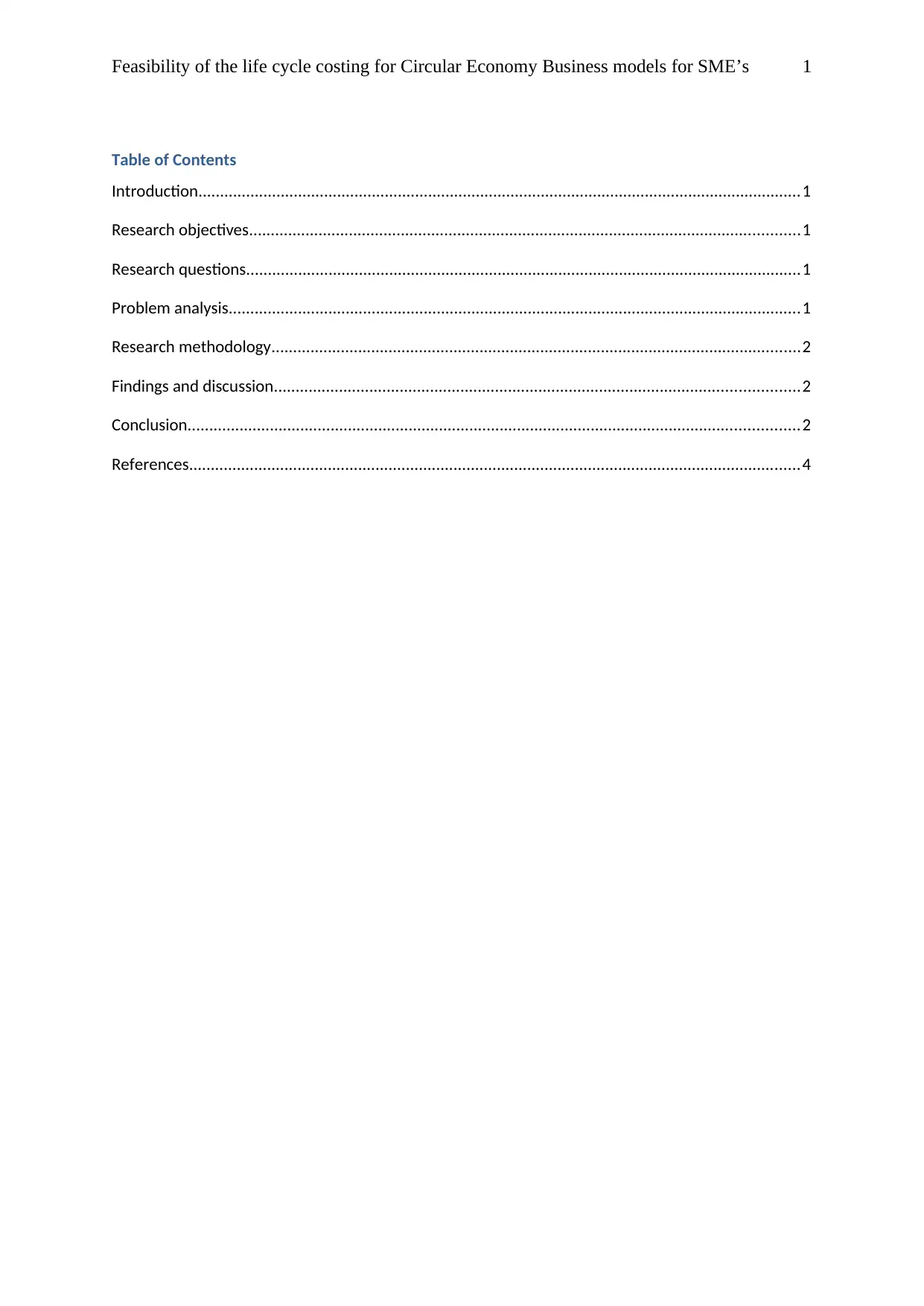
Feasibility of the life cycle costing for Circular Economy Business models for SME’s 1
Table of Contents
Introduction...........................................................................................................................................1
Research objectives...............................................................................................................................1
Research questions................................................................................................................................1
Problem analysis....................................................................................................................................1
Research methodology..........................................................................................................................2
Findings and discussion.........................................................................................................................2
Conclusion.............................................................................................................................................2
References.............................................................................................................................................4
Table of Contents
Introduction...........................................................................................................................................1
Research objectives...............................................................................................................................1
Research questions................................................................................................................................1
Problem analysis....................................................................................................................................1
Research methodology..........................................................................................................................2
Findings and discussion.........................................................................................................................2
Conclusion.............................................................................................................................................2
References.............................................................................................................................................4
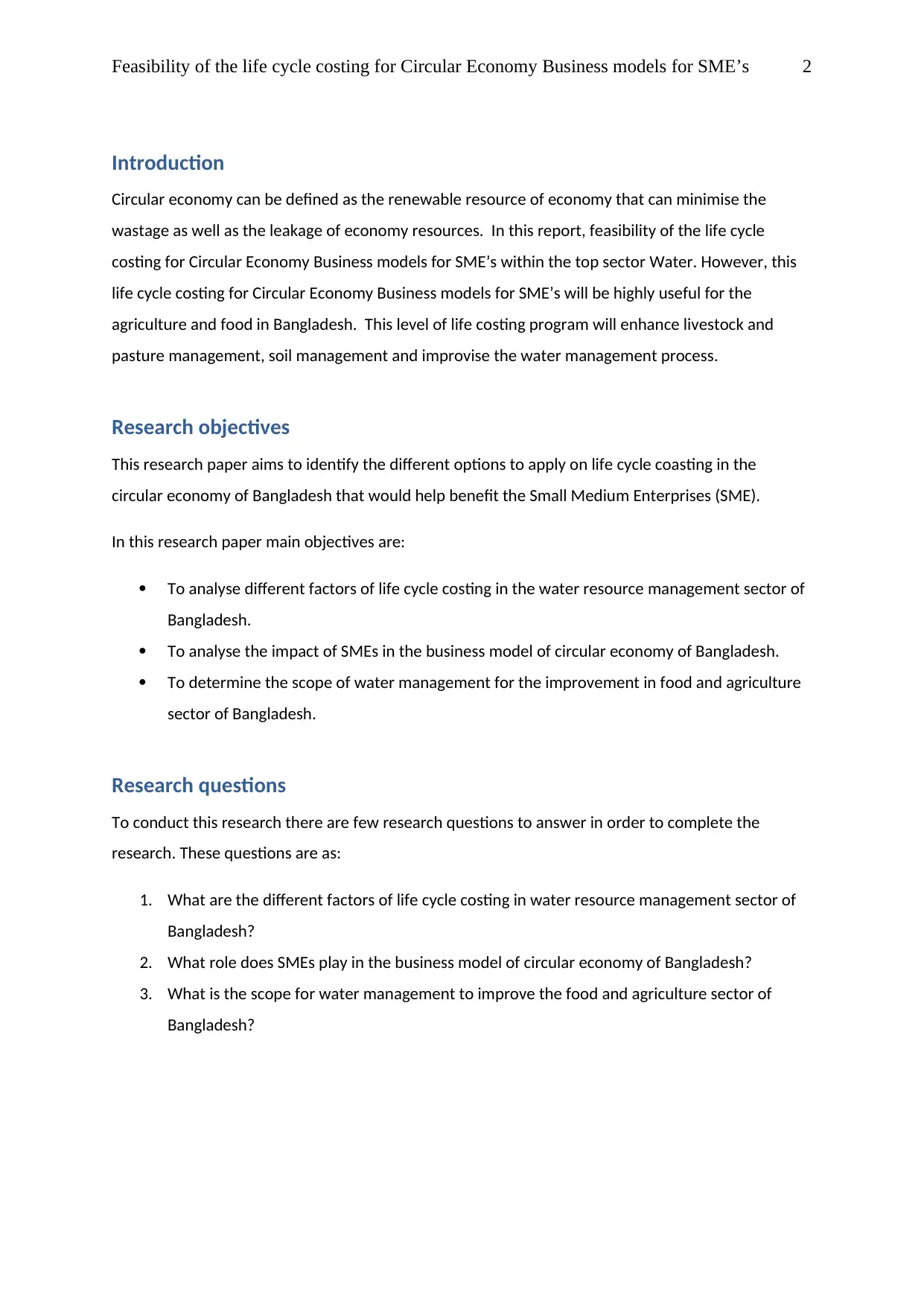
Feasibility of the life cycle costing for Circular Economy Business models for SME’s 2
Introduction
Circular economy can be defined as the renewable resource of economy that can minimise the
wastage as well as the leakage of economy resources. In this report, feasibility of the life cycle
costing for Circular Economy Business models for SME’s within the top sector Water. However, this
life cycle costing for Circular Economy Business models for SME’s will be highly useful for the
agriculture and food in Bangladesh. This level of life costing program will enhance livestock and
pasture management, soil management and improvise the water management process.
Research objectives
This research paper aims to identify the different options to apply on life cycle coasting in the
circular economy of Bangladesh that would help benefit the Small Medium Enterprises (SME).
In this research paper main objectives are:
To analyse different factors of life cycle costing in the water resource management sector of
Bangladesh.
To analyse the impact of SMEs in the business model of circular economy of Bangladesh.
To determine the scope of water management for the improvement in food and agriculture
sector of Bangladesh.
Research questions
To conduct this research there are few research questions to answer in order to complete the
research. These questions are as:
1. What are the different factors of life cycle costing in water resource management sector of
Bangladesh?
2. What role does SMEs play in the business model of circular economy of Bangladesh?
3. What is the scope for water management to improve the food and agriculture sector of
Bangladesh?
Introduction
Circular economy can be defined as the renewable resource of economy that can minimise the
wastage as well as the leakage of economy resources. In this report, feasibility of the life cycle
costing for Circular Economy Business models for SME’s within the top sector Water. However, this
life cycle costing for Circular Economy Business models for SME’s will be highly useful for the
agriculture and food in Bangladesh. This level of life costing program will enhance livestock and
pasture management, soil management and improvise the water management process.
Research objectives
This research paper aims to identify the different options to apply on life cycle coasting in the
circular economy of Bangladesh that would help benefit the Small Medium Enterprises (SME).
In this research paper main objectives are:
To analyse different factors of life cycle costing in the water resource management sector of
Bangladesh.
To analyse the impact of SMEs in the business model of circular economy of Bangladesh.
To determine the scope of water management for the improvement in food and agriculture
sector of Bangladesh.
Research questions
To conduct this research there are few research questions to answer in order to complete the
research. These questions are as:
1. What are the different factors of life cycle costing in water resource management sector of
Bangladesh?
2. What role does SMEs play in the business model of circular economy of Bangladesh?
3. What is the scope for water management to improve the food and agriculture sector of
Bangladesh?
⊘ This is a preview!⊘
Do you want full access?
Subscribe today to unlock all pages.

Trusted by 1+ million students worldwide
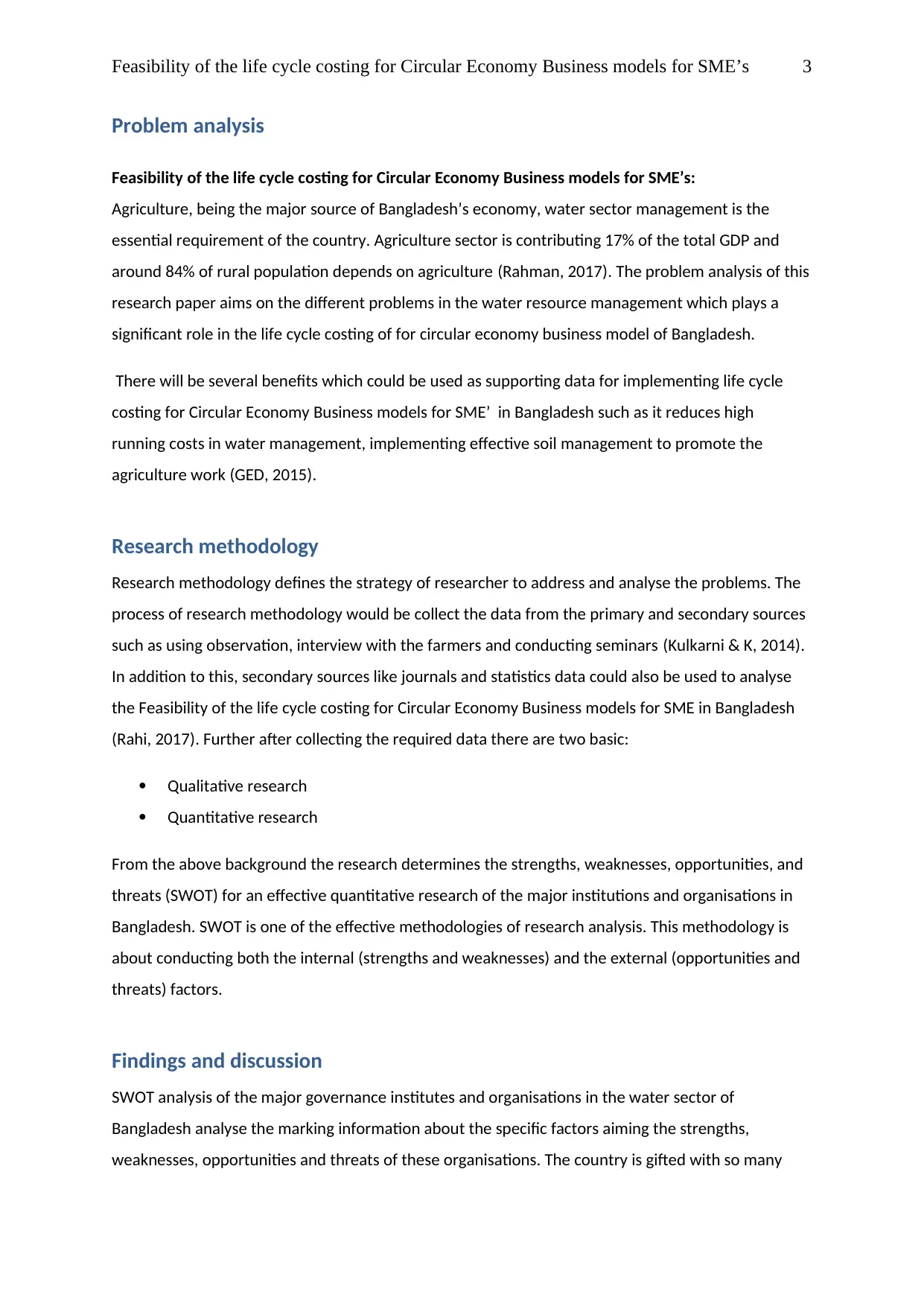
Feasibility of the life cycle costing for Circular Economy Business models for SME’s 3
Problem analysis
Feasibility of the life cycle costing for Circular Economy Business models for SME’s:
Agriculture, being the major source of Bangladesh’s economy, water sector management is the
essential requirement of the country. Agriculture sector is contributing 17% of the total GDP and
around 84% of rural population depends on agriculture (Rahman, 2017). The problem analysis of this
research paper aims on the different problems in the water resource management which plays a
significant role in the life cycle costing of for circular economy business model of Bangladesh.
There will be several benefits which could be used as supporting data for implementing life cycle
costing for Circular Economy Business models for SME’ in Bangladesh such as it reduces high
running costs in water management, implementing effective soil management to promote the
agriculture work (GED, 2015).
Research methodology
Research methodology defines the strategy of researcher to address and analyse the problems. The
process of research methodology would be collect the data from the primary and secondary sources
such as using observation, interview with the farmers and conducting seminars (Kulkarni & K, 2014).
In addition to this, secondary sources like journals and statistics data could also be used to analyse
the Feasibility of the life cycle costing for Circular Economy Business models for SME in Bangladesh
(Rahi, 2017). Further after collecting the required data there are two basic:
Qualitative research
Quantitative research
From the above background the research determines the strengths, weaknesses, opportunities, and
threats (SWOT) for an effective quantitative research of the major institutions and organisations in
Bangladesh. SWOT is one of the effective methodologies of research analysis. This methodology is
about conducting both the internal (strengths and weaknesses) and the external (opportunities and
threats) factors.
Findings and discussion
SWOT analysis of the major governance institutes and organisations in the water sector of
Bangladesh analyse the marking information about the specific factors aiming the strengths,
weaknesses, opportunities and threats of these organisations. The country is gifted with so many
Problem analysis
Feasibility of the life cycle costing for Circular Economy Business models for SME’s:
Agriculture, being the major source of Bangladesh’s economy, water sector management is the
essential requirement of the country. Agriculture sector is contributing 17% of the total GDP and
around 84% of rural population depends on agriculture (Rahman, 2017). The problem analysis of this
research paper aims on the different problems in the water resource management which plays a
significant role in the life cycle costing of for circular economy business model of Bangladesh.
There will be several benefits which could be used as supporting data for implementing life cycle
costing for Circular Economy Business models for SME’ in Bangladesh such as it reduces high
running costs in water management, implementing effective soil management to promote the
agriculture work (GED, 2015).
Research methodology
Research methodology defines the strategy of researcher to address and analyse the problems. The
process of research methodology would be collect the data from the primary and secondary sources
such as using observation, interview with the farmers and conducting seminars (Kulkarni & K, 2014).
In addition to this, secondary sources like journals and statistics data could also be used to analyse
the Feasibility of the life cycle costing for Circular Economy Business models for SME in Bangladesh
(Rahi, 2017). Further after collecting the required data there are two basic:
Qualitative research
Quantitative research
From the above background the research determines the strengths, weaknesses, opportunities, and
threats (SWOT) for an effective quantitative research of the major institutions and organisations in
Bangladesh. SWOT is one of the effective methodologies of research analysis. This methodology is
about conducting both the internal (strengths and weaknesses) and the external (opportunities and
threats) factors.
Findings and discussion
SWOT analysis of the major governance institutes and organisations in the water sector of
Bangladesh analyse the marking information about the specific factors aiming the strengths,
weaknesses, opportunities and threats of these organisations. The country is gifted with so many
Paraphrase This Document
Need a fresh take? Get an instant paraphrase of this document with our AI Paraphraser
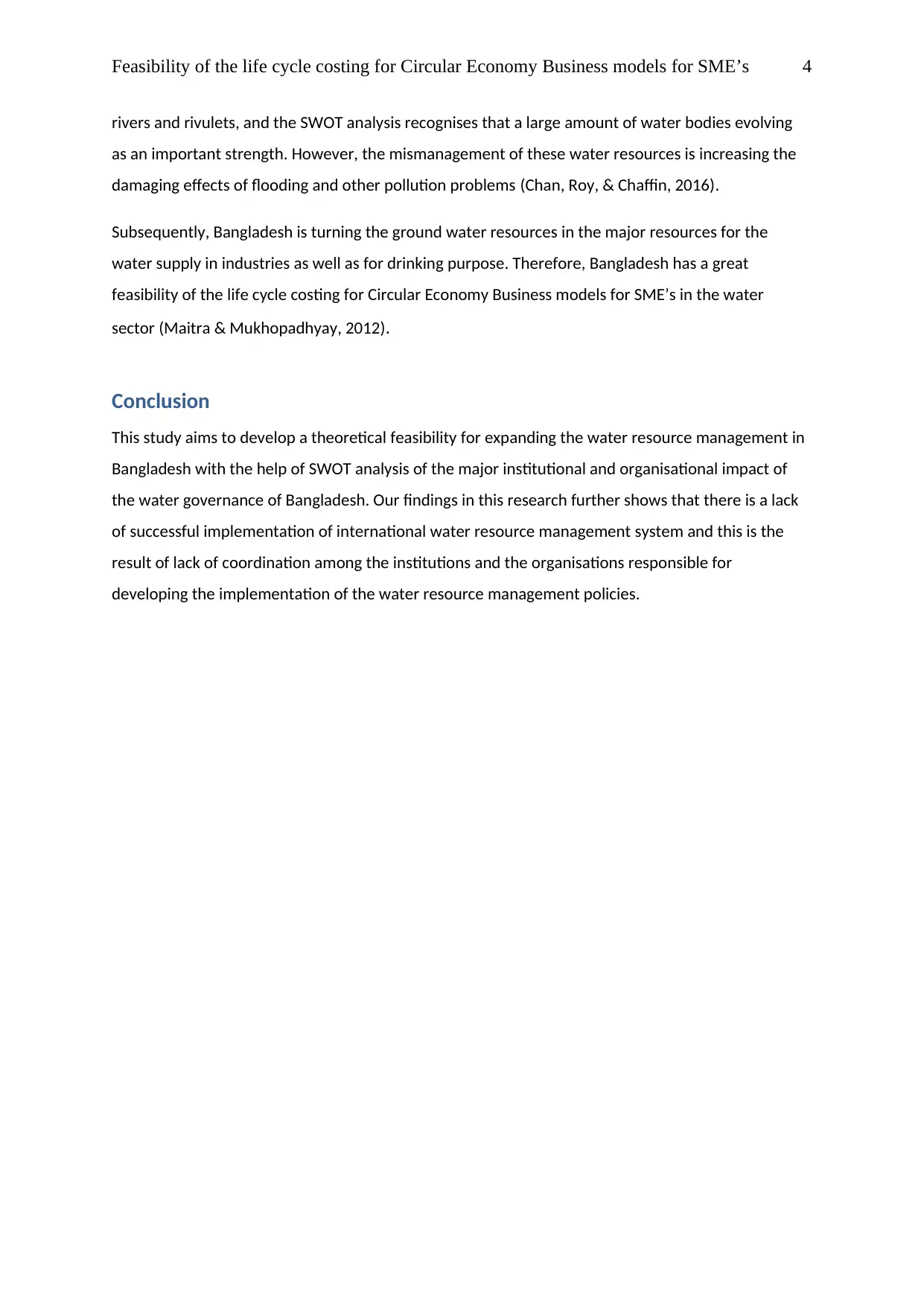
Feasibility of the life cycle costing for Circular Economy Business models for SME’s 4
rivers and rivulets, and the SWOT analysis recognises that a large amount of water bodies evolving
as an important strength. However, the mismanagement of these water resources is increasing the
damaging effects of flooding and other pollution problems (Chan, Roy, & Chaffin, 2016).
Subsequently, Bangladesh is turning the ground water resources in the major resources for the
water supply in industries as well as for drinking purpose. Therefore, Bangladesh has a great
feasibility of the life cycle costing for Circular Economy Business models for SME’s in the water
sector (Maitra & Mukhopadhyay, 2012).
Conclusion
This study aims to develop a theoretical feasibility for expanding the water resource management in
Bangladesh with the help of SWOT analysis of the major institutional and organisational impact of
the water governance of Bangladesh. Our findings in this research further shows that there is a lack
of successful implementation of international water resource management system and this is the
result of lack of coordination among the institutions and the organisations responsible for
developing the implementation of the water resource management policies.
rivers and rivulets, and the SWOT analysis recognises that a large amount of water bodies evolving
as an important strength. However, the mismanagement of these water resources is increasing the
damaging effects of flooding and other pollution problems (Chan, Roy, & Chaffin, 2016).
Subsequently, Bangladesh is turning the ground water resources in the major resources for the
water supply in industries as well as for drinking purpose. Therefore, Bangladesh has a great
feasibility of the life cycle costing for Circular Economy Business models for SME’s in the water
sector (Maitra & Mukhopadhyay, 2012).
Conclusion
This study aims to develop a theoretical feasibility for expanding the water resource management in
Bangladesh with the help of SWOT analysis of the major institutional and organisational impact of
the water governance of Bangladesh. Our findings in this research further shows that there is a lack
of successful implementation of international water resource management system and this is the
result of lack of coordination among the institutions and the organisations responsible for
developing the implementation of the water resource management policies.
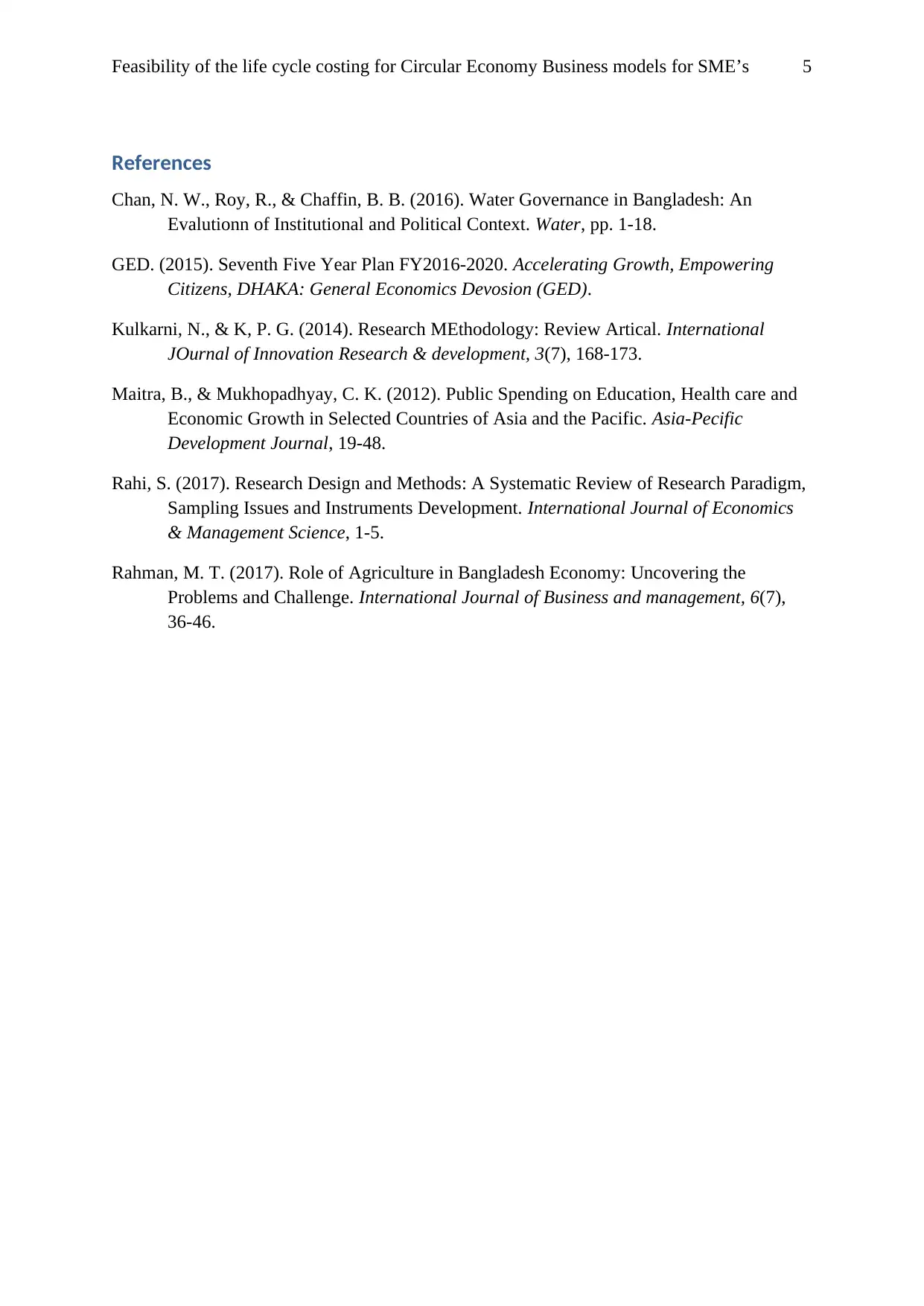
Feasibility of the life cycle costing for Circular Economy Business models for SME’s 5
References
Chan, N. W., Roy, R., & Chaffin, B. B. (2016). Water Governance in Bangladesh: An
Evalutionn of Institutional and Political Context. Water, pp. 1-18.
GED. (2015). Seventh Five Year Plan FY2016-2020. Accelerating Growth, Empowering
Citizens, DHAKA: General Economics Devosion (GED).
Kulkarni, N., & K, P. G. (2014). Research MEthodology: Review Artical. International
JOurnal of Innovation Research & development, 3(7), 168-173.
Maitra, B., & Mukhopadhyay, C. K. (2012). Public Spending on Education, Health care and
Economic Growth in Selected Countries of Asia and the Pacific. Asia-Pecific
Development Journal, 19-48.
Rahi, S. (2017). Research Design and Methods: A Systematic Review of Research Paradigm,
Sampling Issues and Instruments Development. International Journal of Economics
& Management Science, 1-5.
Rahman, M. T. (2017). Role of Agriculture in Bangladesh Economy: Uncovering the
Problems and Challenge. International Journal of Business and management, 6(7),
36-46.
References
Chan, N. W., Roy, R., & Chaffin, B. B. (2016). Water Governance in Bangladesh: An
Evalutionn of Institutional and Political Context. Water, pp. 1-18.
GED. (2015). Seventh Five Year Plan FY2016-2020. Accelerating Growth, Empowering
Citizens, DHAKA: General Economics Devosion (GED).
Kulkarni, N., & K, P. G. (2014). Research MEthodology: Review Artical. International
JOurnal of Innovation Research & development, 3(7), 168-173.
Maitra, B., & Mukhopadhyay, C. K. (2012). Public Spending on Education, Health care and
Economic Growth in Selected Countries of Asia and the Pacific. Asia-Pecific
Development Journal, 19-48.
Rahi, S. (2017). Research Design and Methods: A Systematic Review of Research Paradigm,
Sampling Issues and Instruments Development. International Journal of Economics
& Management Science, 1-5.
Rahman, M. T. (2017). Role of Agriculture in Bangladesh Economy: Uncovering the
Problems and Challenge. International Journal of Business and management, 6(7),
36-46.
⊘ This is a preview!⊘
Do you want full access?
Subscribe today to unlock all pages.

Trusted by 1+ million students worldwide
1 out of 6
Related Documents
Your All-in-One AI-Powered Toolkit for Academic Success.
+13062052269
info@desklib.com
Available 24*7 on WhatsApp / Email
![[object Object]](/_next/static/media/star-bottom.7253800d.svg)
Unlock your academic potential
Copyright © 2020–2025 A2Z Services. All Rights Reserved. Developed and managed by ZUCOL.





